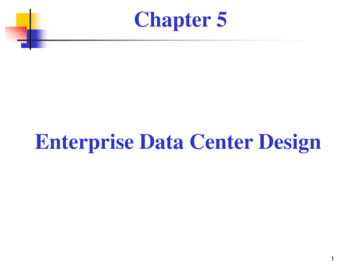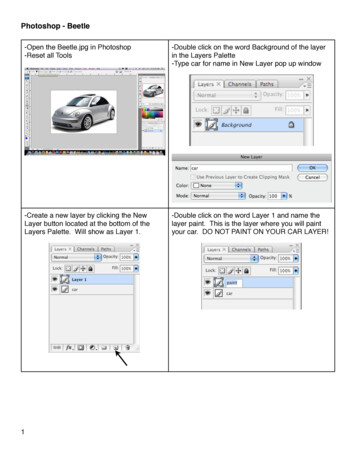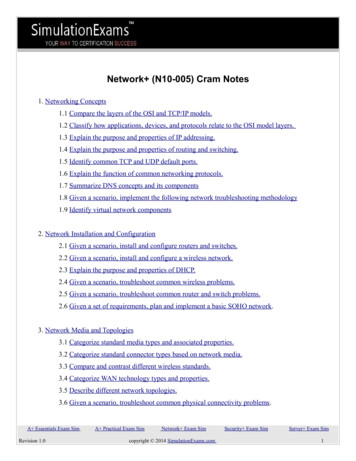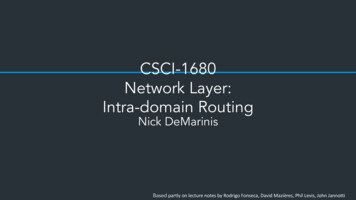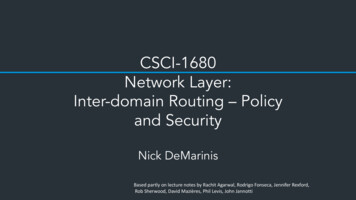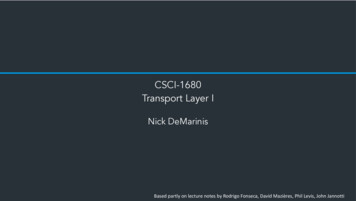
Transcription
CSCI-1680Transport Layer INick DeMarinisBased partly on lecture notes by Rodrigo Fonseca, David Mazières, Phil Levis, John Jannotti
Administrivia Later today: Look for message about IP grading– Meeting slots first week after break (and during break) TCP: Draft of assignment out today– Read it over before break, start when we get back Summer/UTA hiring: Expect a message from me today/tomorrow
TodayLight overview of the transport layer and TCP– Why we need TCP– What components are involved– What you will do in the project
Transport LayerSCTPQUIC Transport protocols sit on top of network layer Problem solved: communication among processes– Application-level multiplexing (“ports”)– Error detection, reliability, etc.
From Lec 2: OSI Reference Model
From Lec 2: OSI Reference ModelLink-Layer Protocol
From Lec 2: OSI Reference ModelINetwork ProtocolLink-Layer Protocol
From Lec 2: OSI Reference ModelTransport ProtocolNetwork ProtocolLink-Layer Protocol
From Lec 2: OSI Reference ModeldsockApplication ProtocolTransport ProtocolNetwork ProtocolLink-Layer Protocol
IBasic transport: UDPfUser Datagram Protocol Unreliable datagram service Adds multiplexing (via ports) and nothing else Checksum is pretty uselessPortnomBms
Next Problem: ReliabilityWe talked briefly about link-layer reliability:ProblemIIMechanismDropped PacketsAcknowledgments TimeoutDuplicate PacketsSequence NumbersPackets out of orderReceiver WindowMaximizing throughputSliding Window (Pipelining)aMF
Next Problem: ReliabilityWe talked briefly about link-layer reliability:ProblemMechanismDropped PacketsAcknowledgments TimeoutDuplicate PacketsSequence NumbersPackets out of orderReceiver WindowMaximizing throughputSliding Window (Pipelining) Single link: things were easy
Transport Layer Reliability Extra difficulties– Multiple hosts– Multiple hops– Multiple potential paths
Transport Layer Reliability Extra difficultiesLINK TYPES SPEED– Multiple hostsDIFFERENT– Multiple hopsDIFFERENT HOST CAPABILITIES– Multiple potential paths What does this mean?– Multiple opportunities for failure– Hosts have different resources– Varying RTTs
Extra Difficulties (cont.) Out of order packets– Not only because of drops/retransmissions– Can get very old packets (up to 120s), must not get confused
Extra Difficulties (cont.) Out of order packets– Not only because of drops/retransmissions– Can get very old packets (up to 120s), must not get confused Unknown resources at other end– Must be able to discover receiver buffer: flow controlTELSENDENTOstoPkIMITDI
Extra Difficulties (cont.)A Out of order packets– Not only because of drops/retransmissions– Can get very old packets (up to 120s), must not get confusedD Unknown resources at other end– Must be able to discover receiver buffer: flow control Unknown resources in the network– Should not overload the network– But should use as much as safely possible to maximize throughputIN USE OFTARNESSSCARCE BW
TCP – Transmission Control KERNEDYour NODEtextstg meatySEGMENTSMTCPSTACKAf IProvinsTO HOSTON REVR BUFM
TCP – Transmission Control Protocol
TCP – Transmission Control Protocol3 Service model: “reliable, connection oriented, full duplex ordered bytestream”
TCP – Transmission Control Protocol Service model: “reliable, connection oriented, full duplex ordered bytestream” Flow control: If one end stops reading, writes at other eventually stop/fail
TCP – Transmission Control Protocol Service model: “reliable, connection oriented, full duplex ordered bytestream” Flow control: If one end stops reading, writes at other eventually stop/fail Congestion control: Keeps sender from overloading the networkI
TCP Specification– RFC 793 (1981), RFC 1222 (1989, some corrections), RFC 5681(2009, congestion control), Was born coupled with IP, later factored out End-to-end protocol– Minimal assumptions on the network– All mechanisms run on the end pointsHOPSJUSTMIDDLEIN THEFORWARDNOT What if you had link-layer reliability instead?PACKETSTCPOFAWARE
Why not provide X on the network layer?X Reliability, security, message ordering Cost– These functionalities are not free: don’t burden those who don’t needthem
Why not provide X on the network layer?X Reliability, security, message ordering Cost– These functionalities are not free: don’t burden those who don’t needthem Conflicting– Timeliness and in-order delivery, for example
Why not provide X on the network layer?X Reliability, security, message ordering Cost– These functionalities are not free: don’t burden those who don’t needthem Conflicting– Timeliness and in-order delivery, for example Insufficient– Example: reliability
End-to-end argument Functions placed at lower levels of a system may be redundant orof little value– They may need to be performed at a higher layer anyway But they may be justified for performance reasonsWIFI
End-to-end argument Functions placed at lower levels of a system may be redundant orof little value– They may need to be performed at a higher layer anyway But they may be justified for performance reasons– Or just because they provide most of what is needed– Example: retransmissions Takeaway: weigh the costs and benefits at each layer
TCP Header01230 1 2 3 4 5 6 7 8 9 0 1 2 3 4 5 6 7 8 9 0 1 2 3 4 5 6 7 8 9 0 1 - - - - - - - - - - - - - - - - - - - - - - - - - - - - - - - - Source Port Destination Port - - - - - - - - - - - - - - - - - - - - - - - - - - - - - - - - Sequence Number - - - - - - - - - - - - - - - - - - - - - - - - - - - - - - - - Acknowledgment Number - - - - - - - - - - - - - - - - - - - - - - - - - - - - - - - - Data U A P R S F Offset Reserved R C S S Y I Window G K H T N N - - - - - - - - - - - - - - - - - - - - - - - - - - - - - - - - Checksum Urgent Pointer - - - - - - - - - - - - - - - - - - - - - - - - - - - - - - - - Options Padding - - - - - - - - - - - - - - - - - - - - - - - - - - - - - - - - data - - - - - - - - - - - - - - - - - - - - - - - - - - - - - - - - FLAGSWHERETHIS PACKETIS INSTREAMLAST SEQUENCERECEIVEDXHOW MUCH SPACETHE RECEIVERHISFOR DATA
Header Fields Ports: multiplexing Sequence number– Correspond to bytes, not packets! Acknowledgment Number– Next expected sequence number Window: willing to receive– Lets receiver limit SWS (even to 0) for flow control Data Offset: # of 4 byte (header option bytes) Flags, Checksum, Urgent Pointer
Header Flags URG: whether there is urgent data ACK: ack no. valid (all but first segment)a PSH: push data to the application immediately RST: reset connection SYN: synchronize, establishes connection FIN: close connection
ESTABLISHINGA tsEXgysYN.REVDtiitESTABLISHEDAGREE ON SEQNUMBERSHERE
Establishing a s Three-way handshake– Two sides agree on respective initial sequence nums If no one is listening on port: server sends RST If server is overloaded: ignore SYN If no SYN-ACK: retry, timeout
Connection Termination FIN bit says no more data to send– Caused by close or shutdown– Both sides must send FIN to close a connectionFINFIN WAIT 2 ACKFINCLOSE WAITCloseLAST ACKTIME WAIT2MSL Typical closeCloseFIN WAIT 1CLOSEDACKCLOSED
Summary of TCP States
Connection EstablishmentSummary of TCP States
Connection EstablishmentSummary of TCP StatesActive close:Can still receive
Connection EstablishmentSummary of TCP StatesActive close:Can still receivePassive close:Can still send!
Next class Sending data over TCP
Based partly on lecture notes by Rodrigo Fonseca, David Mazières, Phil Levis, John Jannotti. Administrivia Later today: Look for message about IP grading -Meeting slots first week after break (and during break) TCP: Draft of assignment out today


